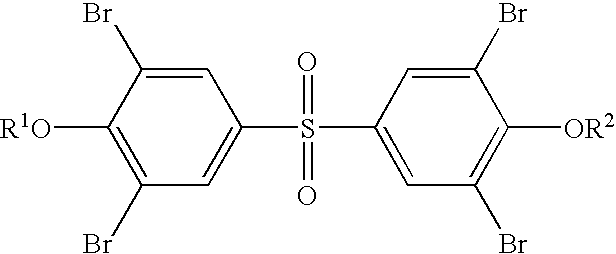Flame Retarded Styrenic Foams and Foam Precursors
a technology of which is applied in the field of flame retarded styrenic foam and precursor, can solve the problems of high cost of some of those flame retardants, and achieve the effects of good solubility, adequate thermal stability, and convenient us
- Summary
- Abstract
- Description
- Claims
- Application Information
AI Technical Summary
Benefits of technology
Problems solved by technology
Method used
Image
Examples
examples 24-27
[0168]The same procedures as in Examples 1-23 were carried out using flame retardants of this invention in combination with another component useful in the preparation of flame retarded styrenic polymer compositions. The polystyrene used was the same kind as used in Examples 1-23 and CA. The other components used were dicumyl (flame retardant synergist), dibutyl tin maleate (thermal stabilizer), and hydrotalcite (thermal stabilizer). The hydrotalcite used was DHT-4A (Kyowa Chemical Company). Dicumyl is a common name for 2,3-dimethyl-2,3-diphenylbutane. The makeup of the test compositions and the test results are summarized in Table 2.
TABLE 2Ex.Flame retardantCat.AdditiveLoadingBromine contentLOI24Tetrabromoxylenesiii)dicumyl, 0.3%2.97 wt %2.25 wt %24.825Brominated phenyl-terminatedvi)dibutyl tin maleate, 2%3.59 wt %2.25 wt %24.5partially hydrogenatedpolybutadiene26Brominated phenyl-terminatedviii)dibutyl tin maleate, 2%4.25 wt %2.25 wt %22.3poly(1,3-cyclohexadiene)27Tetrabromobisphe...
examples 34-37
[0182]Examples 34-37 illustrate the syntheses of tris(dibromoalkyl) benzenetricarboxylates in which each dibromoalkyl group contains, independently, 3 to 8 carbon atoms, brominated aryl-terminated partially hydrogenated polybutadienes, and brominated 1,2-polybutadienes, i.e., flame retardants of categories v) and vi).
example 34
[0183]Triallyl 1,2,4-benzenetricarboxylate (201 g, 0.609 mol) was added to dichloromethane (˜1 kg) in a flask in a circulating bath. Bromine (292 g, 1.83 mol) was added dropwise over 30 minutes to the triallyl benzenetricarboxylate solution, with stirring. The circulating bath temperature was 3 to 6° C., and the reaction temperature ranged from 15 to 25° C. during the bromine addition. After the bromine addition was finished, the reaction mixture was heated to 35° C. for 30 minutes while stirring. Excess bromine was quenched by addition of aqueous sodium sulfite to the reaction mixture, and the reaction mixture was then neutralized by adding aqueous sodium carbonate (10 wt %; to pH ˜10-12). Two layers formed, and the dichloromethane layer was separated from the aqueous layer. The solvent was removed from the separated dichloromethane layer under vacuum. The tris(2,3-dibromopropyl) 1,2,4-benzenetricarboxylate product was a clear, viscous liquid, and contained 59.2 wt % bromine.
PUM
| Property | Measurement | Unit |
|---|---|---|
| wt % | aaaaa | aaaaa |
| diameter | aaaaa | aaaaa |
| diameter | aaaaa | aaaaa |
Abstract
Description
Claims
Application Information
 Login to View More
Login to View More - R&D
- Intellectual Property
- Life Sciences
- Materials
- Tech Scout
- Unparalleled Data Quality
- Higher Quality Content
- 60% Fewer Hallucinations
Browse by: Latest US Patents, China's latest patents, Technical Efficacy Thesaurus, Application Domain, Technology Topic, Popular Technical Reports.
© 2025 PatSnap. All rights reserved.Legal|Privacy policy|Modern Slavery Act Transparency Statement|Sitemap|About US| Contact US: help@patsnap.com


